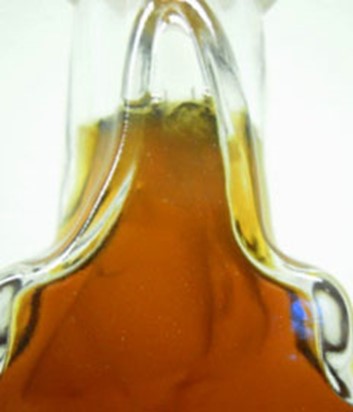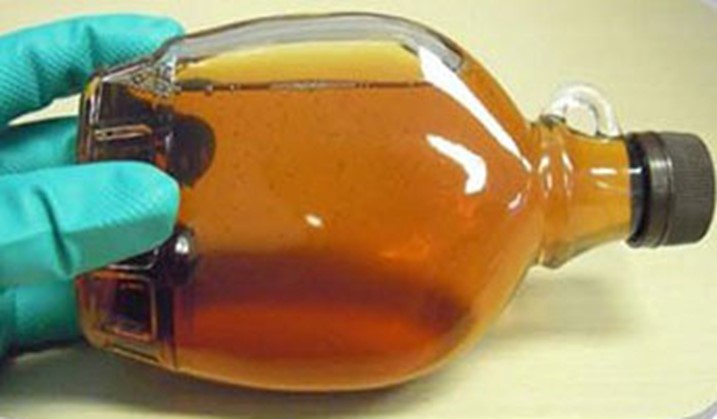Preventing mould growth in maple syrup
Learn about mould and how to prevent mould growth in maple syrup.
Overview
Mould is a type of fungus that breaks down dead material and returns nutrients to the environment. Mould grows quickly in moist, dark spaces such as basements, garbage cans and piles of rotting leaves.
Mould may also be visible on surfaces of food, such as the fuzzy green spots that appear on bread. Moulds have branches and roots. As mould grows, these roots can penetrate deep inside food where it cannot be seen.
Mould growth in maple syrup
Mould spores are present everywhere in the environment. Because of their small size, they cannot be removed by filtration. Maple syrup is particularly susceptible to types of moulds that can grow in high-sugar environments.
Mould prevention in maple syrup is an ongoing challenge for maple syrup producers because the presence of mould in maple syrup can severely impact the perceived quality of that syrup.
Mould starts with dormant spores that will not grow unless the conditions are right. Conditions that contribute to mould growth include:
- temperature
- water activity
- oxygen levels
- pH
- nutrient availability
Water activity is a measure of the water available to support microbial growth. Xerophilic, or "dry-loving", organisms found on maple syrup processing equipment can grow in foods with low water activity.

Figure 1. Mould sometimes grows on the surface of syrup in containers.
Mould prevention
Some factors, such as nutrient levels and pH, are inherent to maple syrup and cannot be controlled. However, as a maple syrup producer, you can control some other factors such as the:
- temperature
- water activity (Brix)
- oxygen availability
You can prevent or limit mould growth in maple syrup by:
- reducing the number of mould spores present in the syrup or containers prior to packing
- destroying mould spores present in a maple syrup after it is packed
- controlling the conditions under which mould may grow after packing
Hot packing
Hot packing is the most common method for destroying mould spores and limiting oxygen availability for mould growth. It involves maintaining the syrup temperature at least 82°Celsius while filling and placing caps on the maple syrup containers.
Once filled and securely capped, each container is then inverted for five to ten minutes to ensure the hot maple syrup contacts and kills all spoilage organisms that may be present in the top neck and inner lid surface of the container. As hot packed syrup cools, it contracts and creates a vacuum, resulting in an anaerobic (oxygen-free) environment that is unsuitable for mould growth.
While 82° Celsius is generally accepted as the threshold temperature to destroy mould spores, some species of mould spores are resistant to high temperatures. Maple producers who increase their packing temperature to as high as 92° Celsius often observe a decrease in mould growth. However, as packing temperature increases, so does the likelihood of suspended solids precipitating out. This can create cloudy syrup.
Retaining high heat can also cause syrup to darken. If you choose to maintain high syrup temperatures, even for a short period of time, you should follow with rapid syrup cooling to minimize darkening of the product.

Figure 2. Hot packed containers are inverted to kill mould spores inside caps.
Since some moulds are more resistant to higher temperatures than others, you should take additional precautions to prevent mould growth.
Cleaning and sanitation
Proper cleaning and sanitation practices throughout the entire production process can reduce the initial mould spore population inside maple syrup and containers. When the initial mould spore population is low, fewer spores need to be destroyed during the packing process. This also limits the potential for mould growth for syrup that is not hot packed or is hot packed improperly.
For more information about cleaning and sanitation, refer to the page entitled Premises and food grade material requirements for maple products in Ontario.
Container storage and pre-heating
Empty containers must be stored in a clean, dry area prior to use. If possible, they should be kept upside down and in their original packaging to help prevent spores and other debris from entering.
Glass, plastic and tin containers and caps intended for packing maple syrup are made of new food grade materials and typically arrive clean from suppliers. However, the surfaces of these containers are not sterile. Regardless of how they are stored, both inner and outer surfaces of the container may be coated with mould spores. You can help reduce mould by pre-heating the containers prior to filling.
When hot packing, small to medium volume glass containers can present a challenge for controlling mould growth. New, designer containers are often made with glass that is thicker than standard containers. If not preheated, these containers can cool the temperature of hot syrup within seconds, down to temperatures that are no longer suitable to kill any spores that may be present inside bottles and cap liners.
Container types
Container types can impact mould growth in maple syrup. The traditional thick walled, high density polyethylene (HDPE) plastic jugs used to store maple syrup are somewhat permeable to oxygen, which allows mould to grow. Some manufacturers coat the exterior surface with a polyvinylidene chloride copolymer ("XL" coating) which serves as an oxygen barrier. Using a bottle with this coating can help limit mould growth after packing.
Seals
Maple syrup containers must be properly sealed. Producers must use caution when packing maple syrup to ensure that containers are sealed properly.
Improperly sealed containers allow oxygen to enter the container, which enables mould to grow. An improper seal may be caused by ill-fitting lids, or by producers over or under torqueing the container lids.
Brix
Maple syrup is a high-sugar product. Sugar molecules in maple syrup "bind" water molecules and reduce their availability to support mould growth. Rather than producing syrup at the minimum regulatory requirement of 66° Brix, many Ontario maple syrup producers aim for a minimum density of 66.5° Brix or slightly higher. This helps to limit the growth of moulds that rely on water availability to grow.
Some types of moulds can grow in foods even with low water availability.
Storage temperatures
Optimal mould growth occurs at ambient temperatures. All syrup should be stored in a consistently cool environment.
Refrigerating or freezing maple syrup slows or prevents potential mould growth. Instructions to "Refrigerate/Freeze after Opening" should appear on the labels of consumer containers of hot packed maple syrup.
Cold packed syrup that is intended for hot packing at a later date should also be refrigerated or frozen. Consumer containers with cold packed syrup should be refrigerated or frozen immediately, and storage instructions should be displayed prominently on the labels of consumer containers of cold packed product.
Summary
Hot packing is a recommended practice for the management of mould spores in maple syrup. Maple producers may adopt additional practices to limit the growth of mould. These practices include:
- heating containers prior to filling
- adopting good sanitation and cleaning practices
- ensuring a minimum density level of 66° Brix
- using non-permeable plastic containers
- minimizing head space in the containers
- capping containers properly
- storing maple syrup at constant, cool temperatures by refrigerating or freezing
Contact us
For more information, please contact OMAFRA’s Food Safety Inspection Delivery Branch by email at fpo.omafra@ontario.ca or call